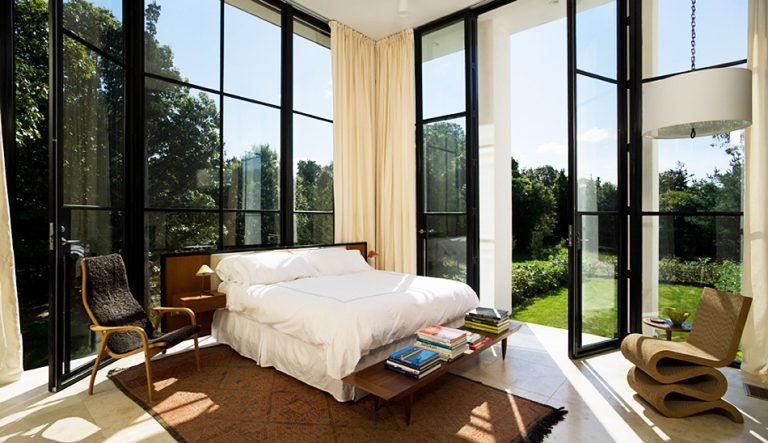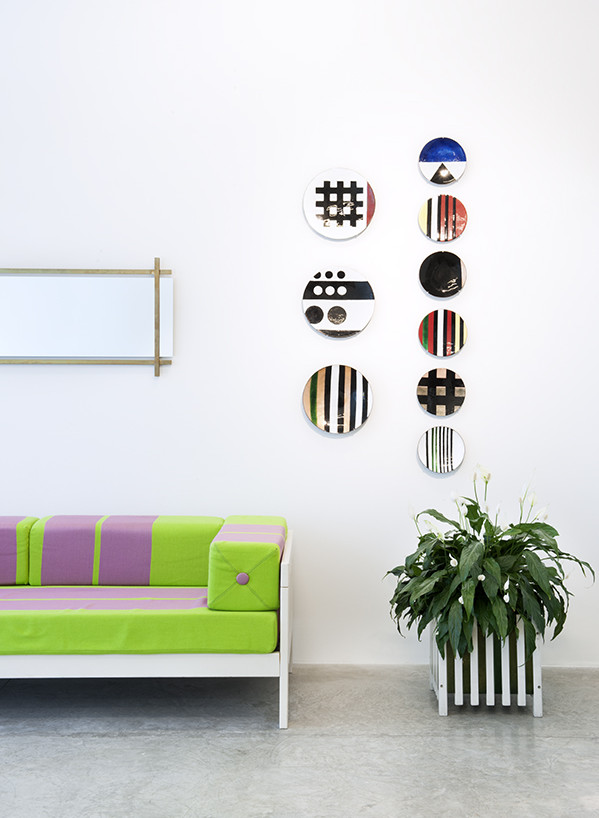
Designer Jennifer Post stands before a painting by Chris Classen in a residence at Miami Beach’s Bath Club. Photo by Ken Hayden
As a child in Ohio, Jennifer Post put a new twist on the requisite “I designed my own room” background: She designed the whole neighborhood. “When I was about eight years old, I would go to people’s houses with my little red wagon, knock on their doors and say, ‘Can I clean your closets and rearrange your room?’ And people would say, ‘sure!’ ”
She’s always been direct, her philosophy being “You either like my work or you don’t.” She is sometimes thought of as a designer who only uses white (not entirely true) and an architectural purist (mostly true). “I’m not a decorator,” she says. “I believe less is more, and I don’t want to add anything to a room that doesn’t have value. But when I let loose, I do let loose.”
Post also notes that she “loved building with blocks, drawing and painting. I never had a Barbie doll and never wanted to play dress-up as a kid. I also traveled extensively with my dad, which I loved.” She became enamored of theater design, which she studied at the University of Cincinnati, near her hometown of Hamilton, and went on to receive an MFA from Michigan State and to pursue postgraduate work in fine arts and theater design at the University of London.
“In theater design, you set the stage for the rest of the play, and that’s how I have come to look at a house — when the red curtain opens, you are setting the stage for living,” she explains. “As on the stage, when you enter someone’s home, the architecture and design should be seamless.”
After styling shop windows and interning at a few architectural firms in New York, Post started her own design studio out of a Hamptons barn she renovated herself. “I created my own discipline and found my own niche,” she says. “I got lucky and got a couple of very good clients, and I was published very early in House & Garden.” Before she knew it, she was on her way to making her mark with what she calls a “sophisticated, elegant, modern and clean” design aesthetic, fueled by a fervent aversion to excess, fluff or over-decoration. Luckily, her clients typically hand her the keys to a great, big tabula rasa that she can really carve into.

A large rolled-steel arc by Bernar Venet, 2004, and Patrice Breteau‘s Twin Birds (on table) add depth to the Bath Club home. Photo by Ken Hayden
That first House & Garden spread opened the door to even more clients, as well as features in Elle Decor, Metropolitan Home, InStyle, The New York Times, Robb Report and Architectural Digest, upon whose AD100 list she has enjoyed a comfortable spot for years. (The tanned, toned blonde once caused a stir with a wintertime visit to AD’s Los Angeles editorial offices in her signature crisp, cuffed shorts, long before they became all the rage.) Post has handled a lot in her 44 years, having built up a client base that includes Matt Lauer, Jennifer Lopez, Simon Cowell and names so big they won’t be identified.
For one such client, a renowned eye surgeon who had come across her work in a magazine, she created a glass aerie in New York’s Time Warner Center, an apartment she calls “classic Jennifer Post.” As is the case with so many of her undertakings, this one was a gut renovation (her favorite kind). “It was a fast-track project — we had eight months to do everything, from the AC to the plumbing to the sculptures,” she says, almost giddy with the memory of the challenge. “The concept was to play on the sophistication and openness of the city,” she says. “He is an older, sophisticated client, not a Wall Streeter or celebrity, and he gave me a great opportunity to mix period pieces with my modern, elegant, contemporary furnishings — it’s the love of my life.” As elsewhere in her designs, those furnishings include touches of shagreen, a restrained use of soothing colors such as periwinkle and silvery sage, stark-black architectural accents and creamy-white lacquered furniture of her own design. She topped off the white dining room with a glossy, all-black canvas and black lacquered chairs. “Talk about classic Chanel — that whole room achieves the old glamour I am going for,” she says. “I don’t like new Dior, or new Chanel, but old Armani, old Calvin Klein and classic New York. It’s definitely a statement in my work. I’m a Bentley, not a BMW.”

A client’s dining room in New York’s Time Warner building. The acrylic-on-canvas painting is by Classen. The 1950s Paolo Buffa chairs are from Karl Kemp Antiques and the table is by J. Robert Scott. Photo by Antoine Bootz
To help her juggle the demands of her success, she maintains a busy headquarters in New York, as well as satellite offices in Los Angeles and Miami. Her lean staff of eight includes “three architects upstairs who do nothing but draw,” along with a few more overachievers not unlike her. “We work ten or eleven hours a day, we go home around nine and we do everything in-house, so it’s always busy. I’m so lucky.”
She sets a flat fee right up front for her soup-to-nuts services, so there’s no confusion. “People think I’m expensive, but once they realize that they get both the architecture and the design — I won’t take a project unless I am doing the design as well — they understand that I’m actually less expensive than hiring both an architect and a designer, and we can create the whole vision seamlessly, from the breakfast room to the moldings to the towels.”
Asked to elaborate on inspirations for her aesthetic, Post says, “I love the early-20th-century greats, like McKim, Mead & White, but contemporary architects are my total inspiration. They’ve made it possible for me to create the seamless interiors that I build in my small, little residential vision. Rem Koolhaas, Renzo Piano and Santiago Calatrava are the gods of architecture and have totally changed our world, from the infrastructures of our cities to the way airports are built.”
And Post has seen a lot of airports. With current projects in New York City and the tony suburbs of Scarsdale, Aspen and Bal Harbour, as well as Moscow and Istanbul, she is a seriously frequent flyer. “I’m home about a quarter of my life,” she says. “I work everywhere, then I travel, travel, travel, and every year I take three weeks off.”
Soon, she will go to Vietnam, Cambodia and Thailand, then to the Middle East, and she will spend the end of the year biking in Africa. “I get on airplanes like I get on a bicycle,” she says. This being the case, getting her on the phone can be a challenge. If she’s in the States, you might catch her at the airport, or on summer Friday afternoons she’s on her way to her beach house in Sagaponack, New York, where the reception en route is spotty at best.
“I plan on traveling and designing forever,” Post tells me in one of our hurried conversations, as she rushes to her next flight at LAX. “The more you travel, the better your work becomes, and the more exposure you have to the world — to architecture, design, colors, materials, textures, forms — the more the whole world changes.”






